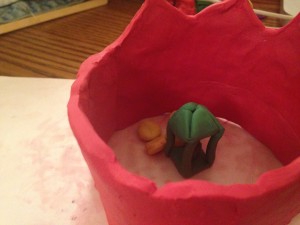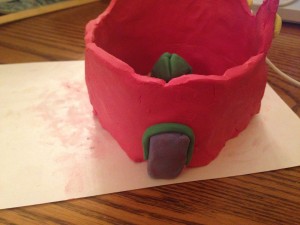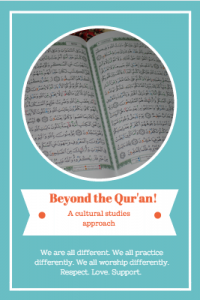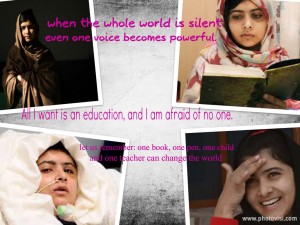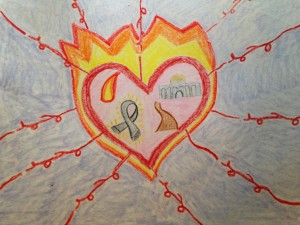The cultural studies approach to this class and this portfolio of artworks encourages individuals to delve into all aspects of Muslim society. This approach, we have studied rituals, recitations, mosques and various forms of artwork ranging from the work of the Ottoman Empire to the modern day expressions of poetry. The cultural studies approach provides an avenue for individuals of all cultures to relate to one another. This approach allows us to recognize that when individuals, cultures, religions feel a powerful draw towards something, they express it in various means that relate to the application of that draw in their personal life. As mentioned before, this can involve the artistic expression of an individual attempting to convey his deepest love of Allah for his audience and it can be as expansive as the various rituals the community practices to encourage unity, love and communal affection. As previously noted, the cultural studies approach creates this connection that all cultures have – all cultures, throughout the ages, have sought various modes of self or communal expression. In regards to Islam, the cultural studies approach allows the interpreter and student to recognize the diversity in practice of Islam.
Though our society tends to focus on how Islam is portrayed in the news and social media, the reality is that the faith is steeped in cultural traditions, rituals and individual expressions of the love of Allah. This portfolio focuses on the global expansion of Islam as it permeates all of the society of the globe. Over the past few months, my understanding and interpretation of Islam has changed dramatically. I realize now that it is nearly impossible to say that one has a “complete” understanding of the meaning of Islam for each expression of Islam is different. The modes of expression range from the stylistic appearance of the mosque to the way Islam is carried out in governmental law. It is the diversity of Islam that makes it so beautiful yet, as I found, there remain unifying factors throughout the global Muslim community.
The moment I realized the true beauty of the diversity within Islam was when we took time to listen to the various recitations and calls to prayer. Though Muslims throughout the world unite under the Qur’an and the dedication to daily prayer, their voices and their cultures create various different tones and rhythm. At the beginning of the semester, we watched a documentary on a competition of the recitation of the Qur’an in Cairo. During this documentary, we listened to various young men and women from around the world recite the Qur’an from memory. Though they were quoting from the same Qur’an, the manner in which they recited ranged depending on their cultural ties.
Though the outward expression of these verses differed, the sentiment behind their expression remained the same. Muslims throughout the world work tirelessly to memorize the Qur’an and recite it just as the Prophet did. When the Prophet first heard the words of the Qur’an, he had no way to write them down. Therefore, he was forced to practice strict memorization and recite the word of Allah for his followers. Throughout the generations, the Qur’an was maintained only by memorization. The art of memorization lead to the practicing of Tajweed which allowed Muslims to spread and teach the message of the Prophet. Many continue to follow in the tradition of the Prophet and memorize all 114 Surahs, which include 6236 verses and approximately 80,000 words. Those who memorize the Qur’an are considered “guardians” and are titled Hafiz for men and Hafiza for women. This universal desire to become the “guardian” of the Qur’an expands acrosse national borders and seas; however, diversity comes in the manner in which it is recited. This diversity comes both from individualistic expression and cultural background.
As mentioned, Islam, through the cultural studies lens, allows individuals to experience the vast diversity of Islam. Because of this lens, I recognize that, in my opinion, there is no “true” form or practice of Islam. The mystical practices of the Sufis, in my limited opinion, are equally as valid as those of the Shia or Sunni. All Muslims, throughout the world, worship in the manner that fits them best to fully exalt Allah and the Prophet Muhammad, their light and unifying factor. Though the practices and expressions are diverse, Muslims throughout the world are united under the Prophet Muhammad.
Muhammad, seen as the veins of the Muslim community and the light of the profane world, is adored and loved by all Muslims. As a Prophet, Muhammad created the Sunnah, or the way of life. Throughout the Qur’an and the Hadith, Muslims are guided on how to live their life in the manner most pleasing to Allah. This includes practicing the five pillars of Islam: Shahadah, Salat, Zakat, Sawm and Hajj. As noted throughout my blog posts and throughout the course, the Prophet is seen as the “veins” of the Muslim community. He is the uniting factor among the Shia, the Sunni, the Sufis and the various other sects of Islam. Though more recently particular sects of Islam have been calling others infidels, it must be noted and affirmed that their faith came from the same source, the same recitation and the same Prophet.
Throughout my blog, I hope to capture the dichotomy between diversity and unity. In my opinion, diversity and unity act hand-in-hand rather than oppose one another. Though these two themes play out in various other religions and faiths around the globe, I think it is most dramatically shown within the context of Islam. As previously mentioned, Islam, a faith of peace and love, is misunderstood and mislabeled by those who use Islam as a means for fulfilling their selfish desires and destructive insecurities. In reality, this “type” of Islam portrayed by radicalism and fundamentalism is nothing like the Islam practiced by many Muslims throughout the world. My portfolio attempts to reconcile the differences between “diversity” and “unity.”
In regards to the rise of fundamentalism and radicalization in today’s society, many solely see Islam as the source of fundamentalism; however, all religious traditions, at various moments throughout history, have had their own radical followers. I am mentioning this fact to encourage the understanding that we are all susceptible to radicalization, no matter what faith we practice. As discussed in The Reluctant Fundamentalist by Mohsin Hamid and as revealed in my interpretation of the novel in artistic form, intelligent and competent individuals are susceptible to radicalization based on their mental and familial stability at the time. In The Reluctant Fundamentalist, Changez finds himself increasingly aggravated post 9/11 as his personal life with his love, Erica, diminishes. Throughout the novel, Changez’s love of Pakistan and its traditions grounds him so that as he feels that one area of his life becomes uprooted, he clings to what he knows and loves best, Pakistan.
Throughout the rest of my blog, I work to enhance the image of unity among diversity. In my interpretation of Professor Asani’s quote, the “love for the Prophet runs like blood in the veins of the Muslim community” (Asani 106), I recognize that Muhammad is the permeating and unifying force of the diversity of religious practice. In my first blog entry, I focused primarily on the unifying forces within the Muslim faith: the flame acting as the image of Muhammad as the light to the world, the Dome of the Rock, the Sunnah and the Burda. These four images all relate to the life and work of the Prophet Muhammad.
Next, my week-five blog post takes diversity into account as it shows that there is no “one face of Islam.” Continuing on with the unifying factor of the Prophet Muhammad, I chose different faces from around the world and used them to spell the Prophet’s name in Arabic script. This shows that Muslims around the world, though they may look different and practice different methods of worship, are all followers under Muhammad’s name.
During week six, I commented on the diversity of mosques. Though they all foster a welcoming location for Muslims to gather in a community and pray as they hear the call to prayer, their design reflects the cultural interpretation of Islam as they are built to fit the communities’ needs. This diversity within a location of worship allows individuals to find themselves and their culture in their own personal faith. Thus, their individual diversity displayed within the external appearance of the mosque leads to an internal unification and trust in Allah and the Prophet.
During week 12, the women who wrote Urdu poetry as means of seeking individual liberation inspired me to reflect on the oppression of women. Female oppression under Islam has acted as a unifying force for some women to rise against the men in society. Women like Malala fight against the odds and unite women around the world to rise up for the noble cause of the unification of men and women under Allah by means of gender equality.
Finally, in week 13, I noticed, as mentioned before, the role of fundamentalism within religion. As previously noted, all members of the community are susceptible to their own weaknesses. These individuals, fearing the loss of stability within their life, develop an irrational hold on what little grounds them. By adding this passage to my blog, I want to continue to emphasize that we must form a united front against fundamentalism by addressing the personal issues of rising fundamentalists. Muslim individuals become radicalized because they feel that their diversity divides them from the greater global community and must unite under the visible unifying front of radical Islam. As noted by former U.S. Special Representatives to Muslim Communities Farah Pandith, we must create a counter-narrative to extremism by changing the way Islam is viewed in our world and thus changing the isolation Muslims feel throughout global communities.
In conclusion, I hope that readers of this blog will recognize the power diversity and unity when they work hand in hand. Bringing diverse backgrounds, interpretations and regional cultural richness under the lens of the cultural studies approach will allow the student and scholar to see the beauty of Islam rather than the minimalist approach given by today’s biased media.

